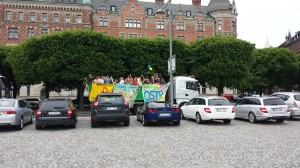Sweden and Finland were originally the same country and the mutual influence shows. Then Tsar Alexander I invaded and in 1809, Sweden ceded Finland to Russia and the two similar countries diverged. Time went on and eventually Finland became a sovereign nation. In its history, Finland allied with Nazi Germany to fight Soviet Russia invading again (and succeeded), thus firmly planting the love-hate relationship between Finland and Russia.
Finland, from the view of an outsider, seems to be a rough mashup of present-day Sweden and Russia. Walking down the street in Helsinki, the Finnish language is predominant, although you are equally likely to hear English, Swedish, or Cyrillic. The converging influences heavily account for the cultural feel in and around Helsinki along with a strong drive and pride for Finnish independence as being markedly different than any one of these mixing forces.
Swedes seem to be a more progressive people with a lower context culture typically being very direct and to the point about what needs to be done. They don’t say thank you much, readily speak English, they are very matter of fact, and very accommodating. A great example of these traits can be seen in the current effort to take on refugees from Syria as well as other displaced people throughout history. In Sweden it is a social faux-pas to take credit for an achievement, however Swedes do like to be credited at another’s insistence. Swedes seem to be a little more upscale as the city of Stockholm was generally more clean and organized
when compared to Helsinki and the cars in Stockholm were cleaner overall. Bicycles are also a big thing in Sweden, and especially Stockholm, while there was not a direct comparison to Helsinki as cars were more prevalent over bikes <insert sideways bike picture>. This also seemed to coincide with the public transit available in Stockholm because we found the metro and busses there much easier to navigate and arrive on time than in Helsinki. Helsinki also had buses and trams, yet somehow they were not on the same level and did not seem as available or inviting as those in Stockholm. Stockholm’s metro stations were clean, did not smell (a surprise), and were all decorated in a fun (and sometime very odd) manner.
Finland and Sweden are both part of the EU, however Sweden kept their currency (the Swedish Krona) and Finland moved to the Euro. This decision, coupled with the weak economies of Greece, Italy, and Spain, among other problems, have largely affected the prices of goods in Finland. Where coffee is a little more expensive in Sweden when we compare a cappuccino for 39 SEK (or 5.88 USD at the time of writing) to 4 USD at home; Finland has felt the affect much more in everyday goods as best exemplified in food prices. A simple lunch hamburger with fries was often running at 19 Euro (25.97 USD) where something of similar quality would range between 8 and 12 USD.
Sweden and Finland act much like siblings that have grown out of a young rivalry situation, yet still
exhibit behavior showing their superiority and independence over one another. Where Sweden is fairly independent and likes to secretly admire American culture and some influence, Finland is more direct in reflecting the influence of American culture, as observed by a massive American car show in market
square in Helsinki; and Russian culture as observed by overhearing Russian being spoken in a handful of public areas, architectural cues, Russian TV channels, and a feeling of Russian influence on the people such as men in track suits and strong-willed women.






